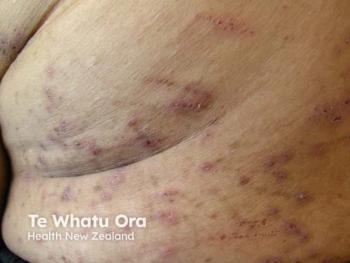
New Study Defines Severity Strata for Vitiligo Using Validated Physician Global Assessment Scores
These findings may provide guidance for future international definitions of degrees of activity and repigmentation in vitiligo.
Researchers from Belgium and the Netherlands recently published a paper in a special issue of the Journal of Clinical Medicine, Prevention and Treatment of Skin Pigmentation Disorders, defining severity strata for vitiligo using validated Physician Global Assessment (PGA) scores.1
They anticipate that the research may aid in more closely defining detailed international definitions for the interpretation of degrees of disease activity and repigmentation.
Background and Methods
According to study authors van Geel et al, while disease scoring and improvement methods exist in this disease state, such as the Vitiligo Disease Activity Score (VDAS15 and 60) and Vitiligo Disease Improvement Score (VDIS15 and 60),2 there remains a need for guidance regarding the definition and interpretation of these scoring tools. By introducing stratification based on outcomes, they noted potential positive implications for future studies' inclusion criteria and clinical profiling.
They sought to evaluate both the validity and reliability of a PGA score for disease worsening and improvement while simultaneously defining activity strata for the above scales/scoring metrics based on their PGA scoring.
The study was conducted at the dermatology department of Ghent University Hospital. Clinical images were used to assess the disease activity and repigmentation in vitiligo patients. Raters independently completed the VDAS15 and 60 and VDIS15 and 60, as well as a PGA on a 5-point scale for both worsening and improvement.
The study involved clinicians from Ghent University Hospital's dermatology department, including 5 dermatology residents, one dermatologist, and one vitiligo expert. The same group conducted preliminary pilot sessions with 66 patients.
Patients of any age with non-segmental vitiligo were eligible if they had at least two clinical photo sets taken 6 (±2) or 12 (±2) months apart. Those with segmental vitiligo were excluded. Their validated PGA scores for activity and repigmentation were used as anchors to stratify the Vitiligo Extent Score (VESplus), VDAS15 and 60, and VDIS15 and 60 results.
Findings
For 34 patients, the interval between photo sets was 6 (±2) months, while for the remaining 32 patients, it was 12 (±2) months. The affected body surface area (BSA) measured by VESplus varied widely among patients, ranging from 0.01% to 36.43%, with a median VESplus of 1.3% and an average of 3.2%. The average age of participants was 37 years (median 39 years), and the average number of vitiligo-involved areas at baseline was 5.89, with a median of 6.
The study confirmed the construct validity of the PGA activity (worsening) score by verifying predefined hypotheses. The correlation between the change in affected BSA and the PGA scores for both activity and repigmentation was strong.
Additionally, very strong correlations were observed between PGA activity/repigmentation and VDAS15 or VDIS15 scores. Multiple regression analysis revealed that changes in disease extent and the number of changing locations significantly contributed to all PGA values for both worsening and improvement.
The interrater reliability of the PGA activity score had an ICC of 0.707. For the PGA repigmentation score, the ICC was 0.701. The intrarater reliability of the PGA activity score was 0.770, while the PGA repigmentation score had an ICC of 0.726.
Small changes in BSA (>0.3%) were sufficient to warrant a PGA activity score of 1. Moderate worsening (PGA = 3) corresponded to more than 27.71% increase in BSA, while much worsening (PGA = 4–5) corresponded to more than 128.75% increase. For repigmentation, an improvement of more than 0% was classified as slightly improved, and more than 4.87% as moderately improved. A PGA score of much improved corresponded to a repigmentation of more than 36.88%.
Conclusions
Potential limitations of the study, as noted by its authors, included its single center design and primary patient demographics of Fitzpatrick skin types II to III and individuals with limited BSA involvement. Severity strata differences in patient age groups may also be considered a limitation.
"The current study confirmed the construct validity and reliability of the PGA for activity (worsening) and repigmentation (improvement), as well as identified potential strata for the VESplus, VDAS15&60 and VDIS15&60," according to study authors. "These strata can be used to interpret numerical results generated by the VESplus, VDAS15&60 and VDIS15&60 and can guide treatment decisions in vitiligo management."
References
- van Geel N, Delbaere L, Mertens L, et al. Exploring the severity strata of disease activity and repigmentation in vitiligo based on validated Physician Global Assessment (PGA) scores. J Clin Med. 2024; 13(9):2680.
https://doi.org/10.3390/jcm13092680 - van Geel, N.; Depaepe, L.; Vandaele, V.; Mertens, L.; Van Causenbroeck, J.; De Schepper, S.; Van Coile, L.; Van Reempts, A.; De Vos, A.S.; Papeleu, J.; et al. Assessing the dynamic changes in vitiligo: Reliability and validity of the Vitiligo Disease Activity Score (VDAS) and Vitiligo Disease Improvement Score (VDIS). J Eur Acad Dermatol Venereol. 2022, 36, 1334–1341.
Newsletter
Like what you’re reading? Subscribe to Dermatology Times for weekly updates on therapies, innovations, and real-world practice tips.


















